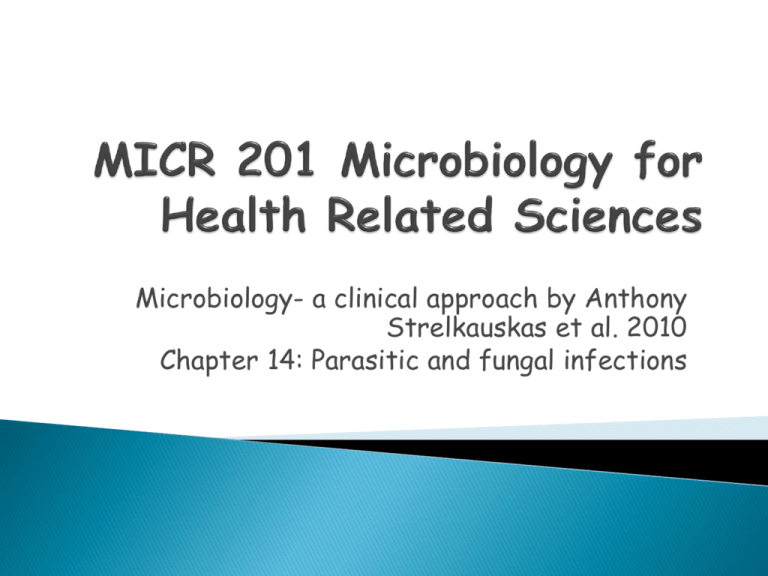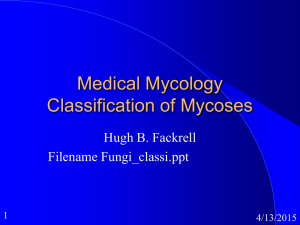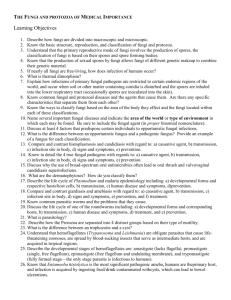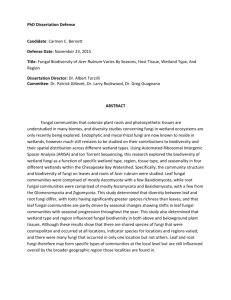MICR 201 Chap 14 2013 - Cal State LA
advertisement

Microbiology- a clinical approach by Anthony Strelkauskas et al. 2010 Chapter 14: Parasitic and fungal infections Over the last five chapters, we have looked at the pathogenicity of bacteria and viruses. In this chapter, we look at the last two groups of infectious organisms, the parasites and the fungi, which are both eukaryotic. Fungal infections are usually opportunistic, but parasitic infections affect billions of people in the world. Parasites can be divided into two groups: ◦ Protozoans – microscopic, single-celled eukaryotes. ◦ Helminths – worms, macroscopic, multicellular eukaryotes with organ systems. Disease causing parasites depend on their infected host for survival. Often involve multiple hosts in which specific developmental stages reached ◦ Definitive host – adults develop, sexual reproduction ◦ Intermediate host – asexual reproduction occurs Parasitic infections major problem worldwide. More than 500 million people infected with malaria. More than 2 million (mostly children) die each year from malaria. Entamoeba are intestinal parasites that infect 10% of the world population. Trypanosoma parasites infect 16 million people in Latin America each year. Often the host response contributes to the pathogenesis. The host defense reaction can cause: ◦ Tissue damage ◦ Allergic or anaphylactic reactions Parasitic protozoans cause a wide variety of infections. Affect large number people throughout the world. Parasitic protozoans vary in size. Contain membrane-bound nuclei and cytoplasm. Cytoplasm divided into: ◦ Inner form – endoplasm ◦ Outer form – ectoplasm Classified on the basis of their methods of movement and reproduction. Most infectious protozoans: ◦ Facultative anaerobes ◦ Heterotrophs ◦ Highly developed reproductive system Actively dividing form is called trophozoite Some form cyst ◦ Way of protecting themselves. ◦ Mechanism of transmission from host to host. Intracellular parasites. Alternate between sexual and asexual reproduction. Important diseases: ◦ Malaria ◦ Toxoplasmosis ◦ Together, affect one third of the world population. Caused by Plasmodium species Febrile illness Found throughout the world Transmitted by bite of female Anopheles mosquito Mortality mainly in children and immunocompromised adults. Oocyst Sporozoites Merozoit es Zygote Gametocytes (female, male) Symptoms of malaria include: ◦ Fever (cold and hot periods, in some forms of malaria synchronized) ◦ Anemia, jaundice ◦ Circulatory changes Anemia is caused by the destruction of red blood cells. ◦ Accompanied by depression of marrow function ◦ Enlarged spleen. Thrombocytopenia is common in malaria. ◦ Bleeding (hemorrhages) Danger: cerebral malaria in infections with P. falciparum ◦ Abnormal behavior, impairment of consciousness, delusions ◦ Paralysis, seizures ◦ Coma and death Erythrocyte aggregation in small blood vessels Coagulation disorder Multiple petechial hemorrhages Inflammation P. ovale and P. vivax can develop into hypnozoites in liver cell These can go dormant for prolonged times Can become reactivated and develop into merozoites causing an acute malaria attack. a) b) c) d) e) Erythrocyte aggregation in the brain Infection of hepatocytes Liberation of large amounts of hemoglobin when merozoits exit erythrocytes All of the above. None of the above. a) b) c) d) e) Flagella Pseudopodia Cilia Pili None. Most primitive form of protozoans: ◦ ◦ ◦ ◦ Multiply by simple binary fission Move by using pseudopodia Produce a chitin wall for protection Referred to as a cyst Entamoeba histolytica is an obligate intracellular parasite. Passed from host to host as cysts: ◦ Fecal-oral route of infection ◦ Ingestion of a single cyst can cause infection Third highest parasitic cause of deaths worldwide: ◦ Only malaria and schistosomiasis are higher Amebiasis is on the rise in the US. Initial infection is via the fecal-oral route. Systemic amebiasis occurs only after colon colonized. Produces several virulence factors and enzymes. ◦ Membrane lesions ◦ Cellular death. Infection usually mild and asymptomatic. ◦ Lesions can open the intestine for bacterial and viral infection. Flagellates widespread in nature. Use flagella for movement through host. Multiply by binary fission. Four flagellates cause human disease: ◦ Trichomonas, Giardia Noninvasive Low morbidity rates No intermediate host required ◦ Leishmania, Trypanosoma Invasive High morbidity rates Frequently lethal Intermediate host required By the protozoan Trypanosoma. Transmitted by vectors: Chronic infection ◦ Motile ◦ Fusiform ◦ Moves in a spiral fashion ◦ African form via tse tse fly – causes sleeping sickness (encephalitis) ◦ American form via kissing bug – causes Chagas’ disease (organ megaly) ◦ Invade endothelial cells in brain (sleeping disease) or organ tissue (Chagas disease) ◦ Escape immune response by changing their change antigens frequently Protozoa that move with cilia Example : Balantidium coli cause dystentery. Image: Left: Balantidium coli cyst. Right: Balantidium coli trophozoite in a wet mount at 1000x magnification. Credit: PHIL, Oregon Public Health Laboratory. Macroscopic multicellular parasites. Body covered by a tough acellular cuticle. Some have suckers, hooks, or plates used for attachment. Helminths have: ◦ ◦ ◦ ◦ Differentiated organs Primitive nervous systems Primitive excretory systems Highly developed reproductive systems Do not have a circulatory system. Three types of parasitic helminths: Nematodes (round worm) Cestodes (tape worm) Trematodes (fluke) Differentiated based on alimentary tract and reproduction Roundworms. Complete intestinal tract. Diecious (male and female individuals). Two subgroups: ◦ Intestinal nematodes ◦ Tissue nematodes sharonapbio-taxonomy.wikispaces.com Characteristics: Fusiform body shape Tough outer cuticle Male and female forms Thousands offspring produced ◦ Eggs must incubate outside the host to become infective ◦ There is a larval form. ◦ ◦ ◦ ◦ Several types of intestinal nematodes: ◦ Pinworms (Enterobius vermicularis) Large roundworms (Ascaris lumbricoides) Intestinal nematode infection produce: ◦ ◦ ◦ ◦ Malnutrition Discomfort Anemia Occasionally death Symptoms depend on number of worms: ◦ Low numbers may be asymptomatic Pinworm, Enterobius vermicularis, ubiquitous parasite of humans. More than 200 million people infected each year. Most of infections in children. Pinworms attach to mucosa of cecum. Females migrate down to perianal tissue to lay eggs. ◦ ◦ ◦ ◦ Eggs stick to tissue, bedding, towels or fingers. Eggs can be inhaled or swallowed. Eggs hatch in the upper intestine. Larvae migrate down to the cecum Largest and most common intestinal nematode. Adult worms live in small intestine. Female parasites lay 250,000-500,000 eggs per day. ◦ ◦ ◦ ◦ Eggs passed into feces. Eggs embryonate in soil for 3 weeks. Very resistant to environmental pressure. Viable for up to 6 years. Once ingested, eggs produce a larval stage. Larvae penetrate intestinal mucosa and invade liver. Exit from hepatic vein, enter the heart, progress to the lung. Rupture in the alveolar spaces. Can be coughed up and swallowed. Symptoms include Worms pass out of the body in a variety of ways: ◦ Fever, coughing, wheezing, shortness of breath ◦ Vomiting, in stool, crawl out of the anus, nose, mouth, and ears. Tissue nematodes can induce disease in: ◦ Tissues ◦ Blood ◦ Lymph system They can live for years in subcutaneous tissues and lymph vessels. Tissue nematodes can discharge live offspring called microfilariae. ◦ Circulate through the blood or tissue ◦ Can be ingested by blood sucking insects. Examples include Wucheria and Trichinella Image: Left: Microfilaria of Wuchereria bancrofti in thick blood smear stained with Giemsa. Center: Photograph of a female Aedes aegypti mosquito as she was in the process of obtaining a "blood meal." Laboratory strains of Aedes aegypti can be infected with Brugia. Credit: DPDx, PHIL Lives in the duodenum and jejunum of flesh eating mammals. Particularly found in swine and bears. Trichinella larvae enter through the host vascular system and are distributed widely. Larvae that penetrate the skeletal muscle survive. ◦ Can become encapsulated in muscle (skeletal, heart) ◦ Can remain viable for 5-10 years. Some larvae enter the central nervous system and cause encephalitis. Cestodes are commonly called tapeworms. They are the largest of the intestinal parasites. They do not have an alimentary tract. ◦ Nutrients are absorbed across the cuticle. Monoecious (hermaphrodites) The adult body has three sections: ◦ Head – the scolex which may have a rostellum (hooks) and has suckers to adhere to the intestinal wall ◦ Regenerative neck ◦ Segmented body with proglottides that contain a hermaphroditic unit Have a bilateral symmetry Have two deep suckers: ◦ One in the oral cavity for food uptake ◦ One on the ventral side of the worm for attachment Have incomplete alimentary tract (mouth, intestine, but no outlet) Almost all are monoecious (exception: Schistosoma, these are also round) Trematodes can live for decades in human tissue and blood vessels. ◦ They produce progressive damage to vital organs. Eggs are excreted from the human host. Hatching releases larvae called miracidia. Miracidia develop into cercariae. ◦ They must reach water in order to hatch. ◦ Miracidia penetrate snails or fish, the intermediate host. ◦ Cercariae are released from the snail or fish. Cercariae enter the definitive host and develop into adults that lay eggs ◦ Schistosoma cercariae invade skin of humans. Three major groups of flukes invade humans: ◦ Lung flukes – Paragonimus species ◦ Liver flukes – Clonorchis species ◦ Blood flukes – Schistosoma species Two to three hundred million people are infected worldwide and up to one million people die each year. There are male and female forms. Schistosome couples mate in the portal vein. ◦ They stay conjoined for life. ◦ They use suckers to ascend the mesenteric vessels. They lay eggs in the submucosal veins Eggs penetrate the veins and enter hollow organs ◦ 300 to 3000 eggs can be laid per day for as long as 35 years. ◦ Intestine ◦ Bladder Eggs induce inflammation ◦ Bladder cancer can develop Mycology is the study of fungi. Fungi are important for the environment. Fungi are commensal organisms. ◦ They are normally harmless to humans. ◦ Fungi can be opportunistic pathogens. ◦ Most fungal infections are opportunistic. Fungi are eukaryotes with cell walls. Fungi use heterotrophic metabolism. ◦ The cell wall contains glucan, mannan, and chitin. ◦ The cell membrane contains ergosterol. ◦ They obtain carbon from decaying organic matter. Most are obligate aerobes but some are facultative anaerobes. ◦ No fungi are obligate anaerobes. There are two forms: ◦ Molds – multicellular, form hyphae, distinct morphology used for diagnostics ◦ Yeasts – unicellular, budding Fungi reproduce either sexually or asexually. Asexual reproduction: Sexual reproduction: ◦ Through conidia ◦ Involves mitotic division and budding ◦ Involves spores - ascospores, zygospores, or basidiospores Some fungi can grow in mold or yeast form. The yeast form requires environmental conditions similar to in vivo. ◦ Proper temperature ◦ Increased nutrients The mold form requires: ◦ Ambient temperatures ◦ Minimal nutrients Classification is based on: ◦ ◦ ◦ ◦ ◦ Nature of the sexual spores Septation of the hyphae rRNA The tissue types they parasitize The diseases they produce Fungal diseases are classified into 4 groups: ◦ Superficial mycoses Top layer of skin or hair shafts, no tissue response ◦ Cutaneous and mucocutaneous mycoses Associated with the skin and mucosa Ringworm Onchomycosis ◦ Subcutaneous mycoses ◦ Deep mycoses Usually seen in immunosuppressed patients with: ◦ AIDS, cancer, diabetes Can be acquired by: ◦ Inhalation of fungi or fungal spores ◦ Coccidiomycosis, histoplasmosis, aspergillosis ◦ Use of contaminated medical equipment Deep mycoses can cause a systemic infection – disseminated mycoses ◦ Can spread to the skin Systemic dissemination of the fungi into the skin Surface lesions are characteristic Thousands of fungal spores are inhaled every day. Fungi are part of normal microbial flora. Fungal infections very uncommon in immunocompetent individuals. Fungal infections are more common in immunodeficient patients. ◦ Candida, Aspergillus, Mucor and Rhizopus Disseminated mycoses are very hard to treat. Pathogenesis of fungal infection is divided into three stages: ◦ Adherence ◦ Invasion ◦ Tissue injury Adherence Several fungal species, particularly yeasts, can adhere to mucosal surfaces. Usually involves an adhesion molecule on the fungus and host cell receptor. Invasion Some fungi are introduced through breaks in the skin. The small size of spores can get past host defenses in the lungs. Some dimorphic fungi can become invasive. ◦ They switch from yeast form to mold form. ◦ The hyphae invade tissues and disseminate. Tissue injury Fungi do not produce exotoxins like bacteria in vivo in humans. Primary tissue injury is due to host inflammatory response. Phagocytes and the adaptive immune response are important to protect against fungal infections Parasitic infections in humans can be caused by protozoans and helminths. These infections affect hundreds of millions of people around the world, and millions die from these infections each year. Protozoan parasites include rhizopods, ciliates, and flagellates. Parasitic helminths are found in three classes: nematodes, cestodes, and trematodes. Medically important fungi can be divided on the basis of the types of infection they cause: superficial mycoses, subcutaneous mycoses, mucocutaneous mycoses, or deep mycoses. Deep mycoses are the most serious fungal infections and can be either localized or systemic.







